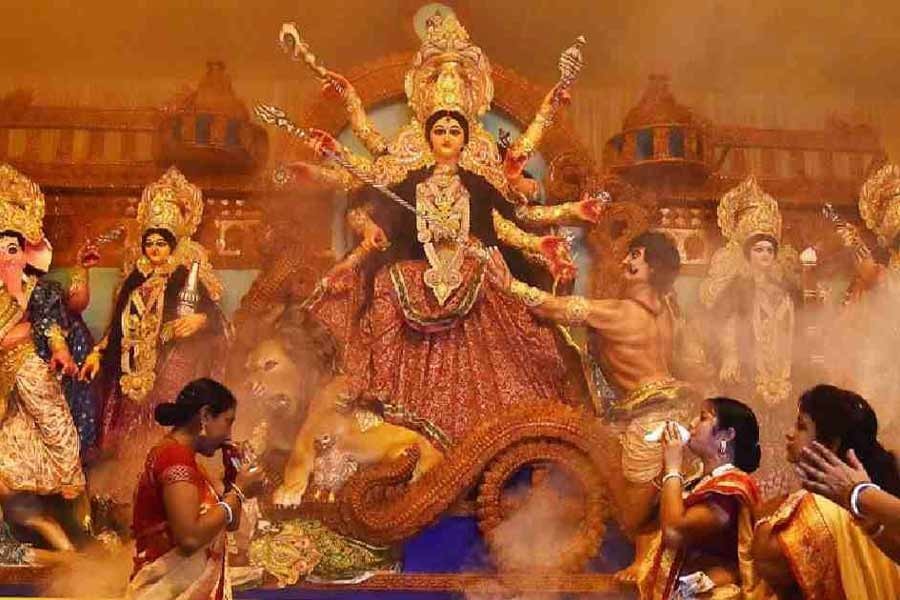In a break-away from centuries-old custom and tradition, Durga puja pandals in West Bengal are going to be no-entry zones for visitors this year. If the directive issued by the Calcutta High Court is complied with, visitors will be barred from entering puja pandals. Declared as containment zones, large puja pandals can allow only 25 and small pandals 15 of their organisers inside. Evidently, the HC ruling comes to deter the mad rush of crowd at this mega annual event in consideration of the raging coronavirus pandemic.
The unrelenting rampage of the deadly virus has been so widespread and telling that, apart from the worldwide colossal head counts, the physical and psychological trauma suffered by those living cannot be assuaged. Gregarious in nature, the species at the top of the order needs each other's company for making life liveable and meaningful but here is a pathogen that has enforced its diktat to stay away. It is anti-life and against the most prized principle of social bonding. Festivals are nothing if not rediscovering the joy, the elan vital of life in company with fellow human beings. But the tiniest of virulent microorganism has enforced an anti-festival regime for people. How frustrating, either respect the regime or perish!
At a time when the choice is between life and death, even the modus operandi of religious festivals is bound to change -- and change radically. First, Eid-ul-Fitr and then Eif-ul-Azha, the two greatest religious festivals of the Muslims were badly affected. Some of the must do's like great congregations at Eidgahs had to be abandoned and devotees were asked to perform their prayers at home. The custom of embracing, after prayer, was discreetly avoided. Even in the holy mosque of Mecca and Medina, only a few devotees -- mostly members on duty inside -- were allowed to perform prayers, declaring the two holy sites off limit to others.
So there is nothing to be surprised if the biggest of all festivals, Sharodia Durgotsab of West Bengal and Bangladesh Hindu communities is celebrated on a low profile. The sub-microscopic pathogen, to go by the prediction made by world's top epidemiologists and virologists and the trend of the second wave of the pandemic, is likely to mar the come X-mass in December next. That is the critical time when the winter will be in its peak and the pandemic also takes a turn for the worst.
Festivals bring people closer. Each festival has its especial significance. Although the religious festivals take their sustenance from each religion's faith, rituals and customs, the inherent spirit also invites an interfaith exchange of good wishes and brotherhood. The core concept of religion teaches people to foster peace and humanitarian values. So the ritualistic parts of religion apart, there is a universal character of the great festivals.
On this count, how the worship of clay images of Durga transcends the barrier of idolatry can be a fascinating story. Here is a deity who alone could destroy the demon that drove away gods and goddesses from heaven. Symbolically, women power has been celebrated through the defeat of the all-conquering demon at the hands of Durga. What is remarkable here is that the deity is considered a mother and a daughter combined and this is a completely unique perception of the Bangalee Hindus. Their compatriots in other states of India do not worship Durga or have a festival like this. Her other incarnation, Shyama or Kali with the same origin from one of the most ancient scriptures, is worshiped in many parts of India.
Now, the Bangalee mind's emotional attachment to the land of birth also imbues him or her with a spirit so pure and elevating that the soil is not soil but motherland -- a mother incarnation. Now is the time when the invocation of mother spirit is needed most. Violence -- mostly sexual -- against women in this part of the world has, of late, also become epidemic. The Bangladesh government could not help reframing the legal provisions for this particular offence. From now on rapists will be awarded death penalty.
However symbolic the image of Durga may be, the connotation of mother and daughter together is definitely sobering. Through her worship, a tribute to feminine power and beauty has been paid. Many have doubted if the death penalty would be a strong deterrent to sexual violence or gross abuse of women and girls. Indeed if anyone can exert a sobering influence on children, it is 'the mother'. In a family environment, actually mother is at the centre of everything. If her dignity is respected and she has her sobering influence on the young ones, no male child can go wayward.
Durga is Uma who visits her father's home annually in autumn with her children. Here the familial bond is renewed as if to remind that the mother incarnate is also a daughter who must be treated as such. Thus the overlapping motherly and filial feelings, when invoked or better say, nurtured in families and society, the demons now prowling the land with the heinous motive of sexual aggression can be defeated and destroyed. Family must be a cradle of nurturing mutual respect between genders and this is where veneration for an idol or motherly epitome translates into respect for women in the context of ordinary domestic life. Thus mothers, acting as the fountainhead of inspiration, can illuminate misguided souls.


